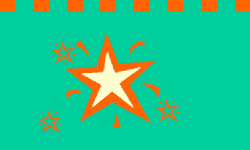THIS LAND IS MY LAND is a book written
by George Littlechild, Canadian artist and member of the Plains Cree Nation. The
book presents a series of Littlechild’s art with accompanying explanations and reflections. The art takes us through histories of the Plains Cree up to the challenge of keeping tradition and hope
alive today.
On the dedication page, Littlechild
thanks his ancestors “for surviving when so many did not.” He then
has a picture of himself and eleven other relatives spanning five generations. By
picturing them here, he honors them and what they have done for him. Littlechild’s
work is mixed media. He uses paint, three-dimensional objects such as feathers
and buttons, pictures, and other materials. He uses very bright colors, bold
strokes and shapes in his art.
In the piece “Four Buffalo Spirits”,
he speaks of the sanctity of the number four in his work and in Cree tradition. “I painted four buffalo because four
is a sacred number…Four is also a healing number. It appears in all my
work. There are four directions, four seasons, four elements, and four kinds
of animals (those who walk, those who fly, those who swim, and those who crawl.)”
Through observations and statements such as these, Littlechild reveals the Cree people’s connection to Nature
without sounding overly “mystical.”
In the first piece, “I Love
the Moon, the Stars, and the Ancestors”, Littlechild gives some background, thanking the Creator for the ancestors and
explaining how the Cree people followed the buffalo. The accompanying art pictures
Chief Joseph Samson with an eagle headdress. Littlechild has painted bold strokes
of color onto some of the feathers. Also pictured is his great-great-grandfather. He appears with gold dots, inside of a heart shape, and under an arch. Large hearts, stars, and moons adorn the painting as well as some actual beadwork. In this way, Littlechild has brought together elements of the past together with the present.
Littlechild explains that the word
“Indian” was imposed by Europeans looking for India, but then uses the term to describe himself and his people. Towards the middle of the book, he states, “We prefer to be called First Nations
or First Peoples, because this was our homeland first.” However, he then
goes back to using the word Indian as the main identifier.
Littlechild goes on to discuss the
devastating effects of the boarding schools that his parents and grandparents were forced to attend. He says that in the absence of their culture, many Indian people, including his own parents, succumbed
to forces such as drug abuse and alcoholism. In “Urban Indian Pain Dance”,
he talks about his brother’s green eyes and how they come from mixed heritage.
He talks about how his brother was able to rise above the challenges and succeed in life. Later, he shares that his art is a way of “healing the pain of the past and helping the next generation
of Indian people.”
This book presents a brief history
of the Cree people and tells George Littlechild’s personal story. By examining
his work and reading about his life, we can see that the culture of the Cree people is not extinct. Littlechild says that he is “reviving (our) culture and traditions.
We are very hopeful and the future looks promising.” After reading
this book, you will know that this is true.

